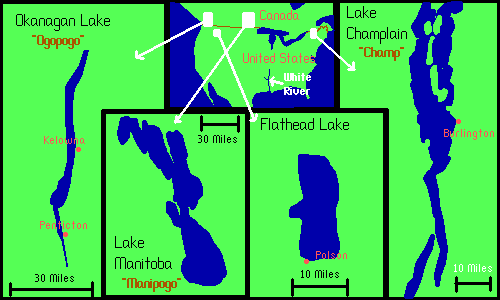pop up description layer
HOME
Cryptozoology UFO Mysteries Aviation Space & Time Dinosaurs Geology Archaeology Exploration 7 Wonders Surprising Science Troubled History Library Laboratory Attic Theater Store Index/Site Map Cyclorama
Search the Site: |
|
Lake Monsters of North America
Strange things in the water. Loch Ness isn't the only lake with a reputation for a Monster. In North America many large, deep, cold water lakes have stories about monsters that go back to before the arrival of Europeans: "Champ" of Lake Champlain - Lake Champlain is a large lake that defines much of the border between the State of Vermont and the State of New York. This body of water is over a hundred miles long and at times thirteen miles wide offering excellent cover for a monster. . The most interesting modern report of Champ was in 1977 by Sandra Mansi. Using her Kodak Instamatic she snapped a picture of a long necked creature emerging from the water. While the photo appears to be authentic the negative was lost limiting the amount of analysis that can be done. For more information on this phenomena, check out our "Champ of Lake Champlain" page.. "Ogopogo" of Okanagan Lake - Stories of Ogopogo go back to before white men settled this section of British Columbia, Canada. The Native Americans called it "Natiaka" meaning "The Lake Monster." The current name comes form a song parody written in 1926. Modern reports of the monster seem to have surged in the 1920's. One, in November 1926, involved 50 to 60 people viewing the monster when they'd come to the lake edge for a baptism ceremony. In addition to scores of reports, there have been alleged photos of the monster, but most of them were of poor quality. No scientific investigation of the monster has been made. The lake, itself, is very much like Loch Ness. Cold, deep water (800 feet) some 79 miles long and 2 1/2 miles wide. "Manipogo" of Lake Manitoba - The name here is a derivative of the better known "Ogopogo." As with Ogopogo there were early Native American sightings and some reports by settlers. Then in 1962 two men in a boat got a picture. Looking like a snake in the water the picture isn't clear enough to prove the existence of the monster. The appearance does match up with other eye-witness reports of the creature: A long tubular body at least a foot in diameter. In the early 60's Professor James A. McLeod of Manitoba University investigated the creature by trying to locate it's remains. If there is a breeding population in the lake they should be leaving carcasses and bones when they die. McLeod found none. There have been occasional sightings of monsters at other lakes and rivers in North America including Flathead Lake, Montana and the White River in Arkansas. (Some authorities believe the Arkansas sighting was a lost elephant seal.) A monster reported in the late 1800's in Silver Lake, New York, turned out to be a hoax perpetrated by a local hotel owner who profited from the resulting tourist dollar. Copyright Lee Krystek, 1996-2000. |
|
Related Links |
|
|




